


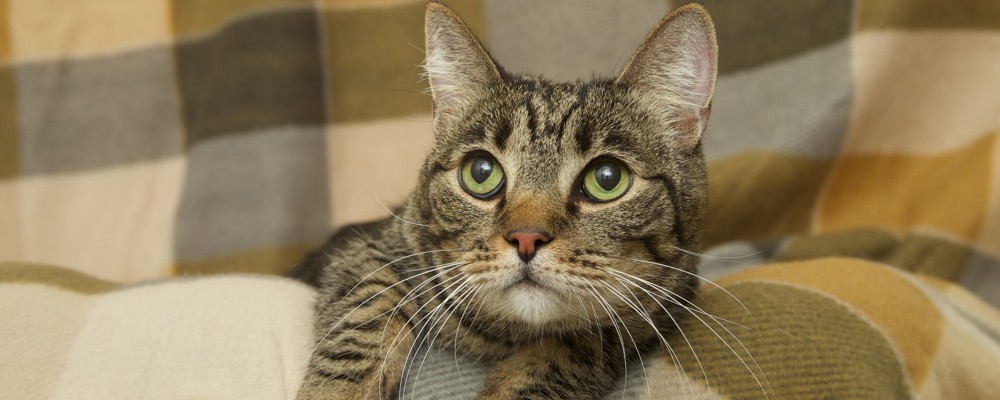
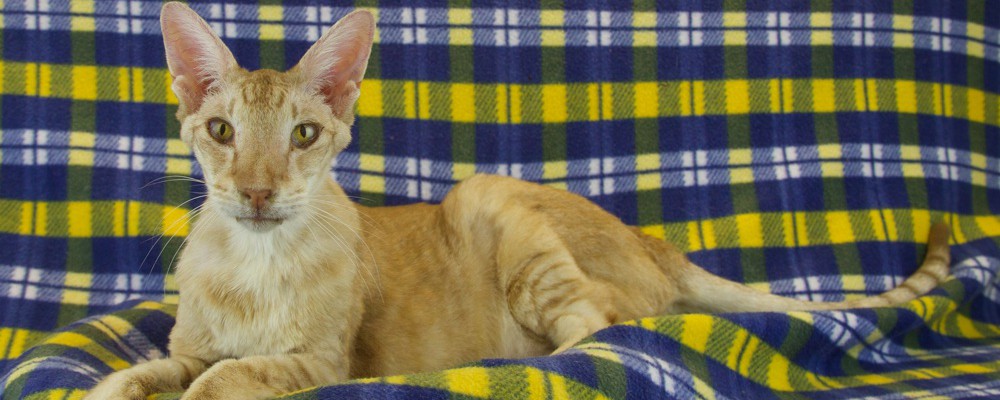
In a word, confidence…
-
- Confidence in the diagnosis
- Confidence in the radioiodine dosing methodology
- Confidence in the ongoing care provided for your cat during its hospitalization
- Confidence in the release criteria
- Confidence in the follow-up care
Confidence in the diagnosis
Hyperthyroidism is caused by one or more small and usually benign tumor(s) in the thyroid gland1,2. These tumors function autonomously to produce excessive thyroid hormone levels. The diagnosis of hyperthyroidism is usually straightforward and is typically made with the combination of historical symptoms, physical findings and laboratory evaluation3. Generally, a significant elevation in the T4 (thyroxine) level, in conjunction with appropriate historical and physical findings is sufficient to confidently allow a diagnosis of hyperthyroidism. Unfortunately, not all cats with hyperthyroidism have an elevated T4. Sometimes cats with early or mild hyperthyroidism have normal T4 levels4. As a result other tests have been described that allow the diagnosis of hyperthyroidism in cats with early or mild disease5,6. Currently the non-protein bound or “free” T4 as measured by a methodology called equilibrium dialysis (fT4ed ) is considered the most sensitive laboratory test for the diagnosis of hyperthyroidism7. Unfortunately, this test is NOT perfect either. Between 6% and 12 % of the cats with elevated fT4ed values are not hyperthyroid. A procedure called thyroid scintigraphy (a diagnostic imaging procedure) has long been considered the “gold standard” in the diagnosis of feline hyperthyroidism8. This procedure allows the direct visualization of the thyroid gland and the ability to see the small tumor(s) responsible for hyperthyroidism in cats. This procedure utilizes the physiology of the thyroid gland to create an image and is so sensitive that it can actually demonstrate the presence of these tumors long before they become clinically significant or result in laboratory value abnormalities. At Advanced Veterinary Medical Imaging, thyroid scintigraphy is performed before every radioiodine therapy to ensure the accuracy of the diagnosis.Confidence in the radioiodine dosing methodology
Numerous methods for determining the radioiodine dose for cats with hyperthyroidism have been described in the veterinary literature9,10,11,12,13,14. These methods are quite variable but include 2 basic categories, namely- individual or “patient specific” dose determination and
- fixed or “one size fits all” dosing.
Confidence in care
The care needed by cats undergoing radioiodine therapy is usually minimal. The radioiodine treatment itself is not associated with any reported side effects. Never the less the average age of the cat’s with this disease is 13 years. The effects of the chronic thyroid hormone excess on other organ systems in the body, especially the cardiovascular system, can be significant19,20,21. Major concurrent conditions necessitating ongoing therapy are common in these patients. Common concurrent conditions include but are not limited to diabetes mellitus, congestive heart failure, renal insufficiency, and inflammatory bowel disease. Some facilities that perform radioiodine therapy rely on patient care and monitoring provided by veterinary technicians who report to off site veterinarians regarding the condition of the hospitalized patients. Furthermore, some radioiodine therapy facilities utilize the services of out of state consultants to perform the actual radioiodine therapy. These out of state consultants fly in for the few hours necessary to administer the radioiodine treatment and then leave the patients in the care of individuals unlicensed to administer radioactive materials. Needless to say, this approach is a cause for great concern among many licensed radioactive materials users. At Advanced Veterinary Medical Imaging all patients receiving radioiodine therapy are evaluated, treated and then supervised for the duration of their hospital stay by Dr. Michael Broome. Dr. Broome is both a pioneer and recognized expert in the use of radioactive iodine for the treatment of feline hyperthyroidism. Following the completion of a Master’s project in comparative thyroid physiology at U.C. Davis, Dr. Broome became the first veterinarian in a private practice in the United States to receive a license for the use of radioactive iodine in the treatment of feline hyperthyroidism. Dr. Broome has authored numerous articles on the topic and personally cared for over 10,000 cats with hyperthyroidism using radioiodine. Dr. Broome is regularly consulted by the California Department of Health regarding issues of radiation safety relating to the use of radioiodine in animals.Confidence in the release criteria utilized by the facility
Cats undergoing radioiodine therapy are hospitalized following that therapy for a variable period of time to allow for the excretion of the majority of the radioiodine prior to their release to the client. The collected radioactive waste material is generally “held for decay” by the radioactive materials license holder. These requirements are regulated by federal codes but usually implemented by more local government agencies, generally at the State government level. Interestingly, these federal regulations are not specific to the use of radioiodine for the treatment of hyperthyroidism in cats. Indeed the regulations were written before cats were recognized as developing hyperthyroidism. Rather, the regulations were written with the general goal of ensuring that those licensed to use radioactive materials of any kind, did so with limits imposed upon them to ensure against inappropriate radiation exposure to members of the general public. Specifically, the federal codes are designed to preclude the general public from receiving greater than 0.1 rem/year as the result of the actions of radioactive materials license holders. Since clients with hyperthyroid cats are members of the general public, this is the major motivation for requiring hospitalization following radioiodine therapy. The development of standardized release criteria based on the measured radiation exposure emitted from the cat seems at first glance to be straightforward. However, the dramatic effect of varying proximity between the person and the cat (the source of the radiation) needs to be taken into consideration. Radiation exposure follows the “inverse square law”. This means that as the distance between a person and a source of radiation is doubled, the exposure level is decreased by a factor of 4. At what location relative to the cat should one measure the exposure level when determining release criteria? Obviously one should attempt to reproduce the anticipated proximity between the cat and the people with whom the cat lives. Different release criteria can therefore be chosen based on different anticipated proximities to the cat. Currently state regulatory agencies in different states have interpreted the federal codes differently. This has lead to different release criteria for facilities performing the same procedure in different states. Anxious clients will often encourage the release of their cats following the radioiodine therapy before they have reached the release criteria established by the authoritative regulatory agency. Referring veterinarians should have confidence that the release criteria used by a facility providing radioiodine therapy have been developed with the best interest of the patient and the client in mind. A recent decision by the California State Department of Health supports the earlier release of cats following radioiodine therapy for hyperthyroidism. Cats can now be discharged in as little as 3 days following radioiodine therapy!Confidence in the follow-up care provided
The results of the radioiodine therapy manifest themselves over a period of several weeks to months. A familiarity with the management of these patients and the assurance of ongoing communication with the client and referring veterinarian should be expected from the facility providing radioiodine therapy. Advanced Veterinary Medical Imaging has been providing radioiodine therapy to patients in southern California since 1986. Both telephone and written follow-up with referring veterinarians and client’s is a major part of our commitment to providing the best care possible for these patients. Finally it is of paramount importance to note the following: Licensing by a federal or state agency to provide radioiodine therapy to cats with hyperthyroidism is NOT a guarantee of proficiency in this procedure. Referring veterinarians should thoroughly familiarize themselves with the methods used by facilities they refer patients to for radioiodine therapy.|
Thyroid Scintigraphy
To see more examples of thyroid scintigraphy with additional description see the thyroid scintigraphy page
|
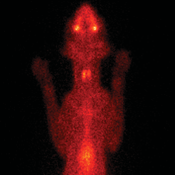
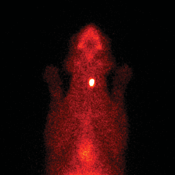
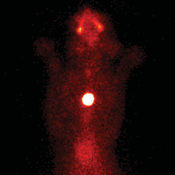
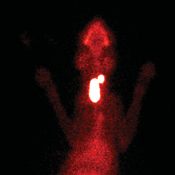
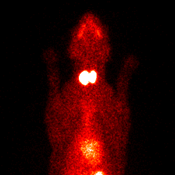
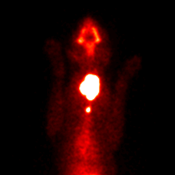
|
What should you look for in a facilty providing radioiodine therapy for feilne hyperthyroidism? |
|
Confirmation of the diagnosis with thyroid scintigraphy. |
| On site radioactive materials license holder. |
| Patient dosing tailored to individual cat's thyroid tumor. |
| Avoid situations relying on out of state "consultants" who perform the radioiodine therapy but will not be around for the duration of the patient's hospitalization. |
| Ability to recognize and adjust radioiodine therapy dose for cats with functional thyroid carcinomas.
(The only noninvasive way to accomplish this is with thyroid scintigraphy.) |
| Experience in treating and more importantly managing cats with hyperthyroidism. |
References:
- Peterson ME, Becker DV, Hurley JR, et al. Spontaneous hyperthyroidism in the cat. American College of Veterinary Internal Medicine Scientific Proceedings, Seattle, July 1979. (abstract).
- Holzworth J, Theran P, Carpenter JL et al. Hyperthyroidism in the cat: ten cases. J Am Vet Med Assoc 1980 Feb 15;176(4):345-53.
- Peterson ME, Kintzer PP, Cavanagh PG, et al. Feline hyperthyroidism: pretreatment clinical and laboratory evaluation of 131 cases. J Am Vet Med Assoc 1983 Jul 1;183(1):103-10.
- Peterson ME, Graves TK, Cavanagh I. Serum thyroid hormone concentrations fluctuate in cats with hyperthyroidism. J Vet Intern Med 1987 Jul-Sep;1(3):142-6.
- Peterson ME, Graves TK, Gamble DA. Triiodothyronine [T3] suppression test--An aid in the diagnosis of mild hyperthyroidism in cats. J Vet Intern Med Sep/Oct’90 4[5]:233-238.
- Peterson ME, Broussard JD, Gamble DA. Use of the thyrotropin releasing hormone stimulation test to diagnose mild hyperthyroidism in cats. J Vet Intern Med 1994 Jul-Aug;8(4):279-86.
- Peterson ME, Melian C, Nichols R. Measurement of serum concentrations of free thyroxine, total thyroxine, and total triiodothyronine in cats with hyperthyroidism and cats with nonthyroidal disease. J Am Vet Med Assoc 2001 Feb 15;218(4):529-36.
- Kintzer PP, Peterson ME. Thyroid scintigraphy in small animals. Semin Vet Med Surg (Small Anim) 1991 May 6[2]:131-9.
- Turrel JM, Feldman EC, Hays M et al. Radioactive iodine therapy in cats with hyperthyroidism. J Am Vet Med Assoc 1984 Mar 1;184(5):554-9.
- Meric SM, Rubin SI. Serum thyroxine concentrations following fixed-dose radioactive iodine treatment in hyperthyroid cats: 62 cases (1986-1989). J Am Vet Med Assoc. 1990 Sep 1;197(5):621-3.
- C. T. Mooney. Radioactive iodine therapy for feline hyperthyroidism: Efficacy and administration routes J Small Anim Pract 35[6]:289-294 Jun’94.
- Malik R, Lamb WA, Church DB. Treatment of feline hyperthyroidism using orally administered radioiodine: a study of 40 consecutive cases. Aust Vet J 1994 Aug;71(8):270.
- Theon AP, Van Vechten MK, Feldman E. Prospective randomized comparison of intravenous versus subcutaneous administration of radioiodine for treatment of hyperthyroidism in cats. Am J Vet Res 1994 Dec;55(12):1734-8.
- Peterson ME, Becker DV. Radioiodine treatment of 524 cats with hyperthyroidism. J Am Vet Med Assoc 1995 Dec 1;207(11):1422-8.
- Broome MR, Turrel JM, Hays MT. Predictive value of tracer studies for 131I treatment in hyperthyroid cats. Am J Vet Res 1988, 49; 193-197.
- Hays MT, Broome MR, Turrel JM. A multicompartmental model for iodide, thyroxine, and triiodothyronine metabolism in normal and spontaneously hyperthyroid cats. Endocrinology. 1988 Jun;122(6):2444-61.
- Broome MR, Hays MT, Turrel JM. Peripheral metabolism of thyroid hormones and iodide metabolism in healthy and hyperthyroid cats. Am J Vet Res 1987, 48; 1286-1289.
- Hays MT, Turrel JM, Broome MR. Assessing degree of hyperthyroidism in cats. J Am Vet Med Assoc 1988 Jan 1;192(1):7.
- Peterson ME, Keene B, Ferguson DC, Pipers FS. Electrocardiographic findings in 45 cats with hyperthyroidism. J Am Vet Med Assoc 1982 Apr 15;180(8):934-7.
- Kienle RD, Bruyette D, Pion PD. Effects of thyroid hormone and thyroid dysfunction on the cardiovascular system. Vet Clin North Am Small Anim Pract 1994 May;24(3):495-507.
- Fox PR, Peterson ME, Broussard JD. Electrocardiographic and radiographic changes in cats with hyperthyroidism: comparison of populations evaluated during 1992-1993 vs. 1979-1982. J Am Anim Hosp Assoc 1999 Jan-Feb;35(1):27-31.

